Past Year Questions: Fluid Kinematics | Topic wise GATE Past Year Papers for Civil Engineering - Civil Engineering (CE) PDF Download
Q1: A flow velocity field for a fluid is represented by
for a fluid is represented by
In the context of the fluid and the flow, which one of the following statements is CORRECT? [2024, Set-I]
(a) The fluid is compressible and the flow is irrotational
(b) The fluid is incompressible and the flow is irrotational.
(c) The fluid is compressible and the flow is rotational.
(d) The fluid is incompressible and the flow is rotational.
Ans: (d)
Continuity equation for incompressible flow:

= 0 (Incompressible Flow)
Q2: The velocity components in the x and y directions for an incompressible flow are given as u=(-5+6x) and v=-(9+6y), respectively. The equation of the streamline is [2020, Set-II]
(a) (-5+6x)-(9+6y)= constant
(b) 
(c) (-5+6x)(9+6y)= constant
(d) 
Ans: (c)
Given
u = −5+6x
v = −(9+6y)
Equation of streamline
dx/u = dy/u
Integrating it,
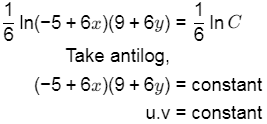
Q3: Uniform flow with velocity U makes an angle θ with the y-axis, as shown in the figure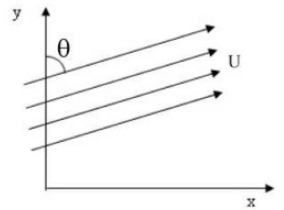 The velocity potential (Φ), is [2020, Set-I]
The velocity potential (Φ), is [2020, Set-I]
(a) ± U(x sinθ + y cosθ)
(b) ± U(y sinθ − x cosθ)
(c) ± U(x sinθ − y cosθ)
(d) ± U(y sinθ + x cosθ)
Ans: (a)
Velocity in x-depth, ux = u sinθ
Velocity in y-depth, uy = u cosθ
Integratingit

Integrating it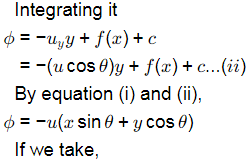


Q4: The velocity field in a flow system is given by v = 2i+ (x + y)j + (xyz)k. The acceleration of the fluid at (1, 1,2) is [2019 : 1 Mark, Set-II]
(a) 4i + 12k
(b) 2i + 10k
(c) j + k
(d) 4j + 10k
Ans: (d)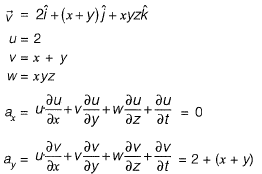

Q5: A flow field is given by u = y2, v = - xy, w = 0.Value of the z-component of the angular velocity (in radians per unit time, up to two decimal places) at the point (0, -1 ,1 ) is _____. [2018 : 1 Mark, Set-I]
Ans:

Q6: The velocity components of a two dimensional plane motion of a fluid are 

The correct statement is: [2015 : 2 Marks, Set-II]
(a) Fluid is incompressible and flow is irrotational
(b) Fluid is incompressible and flow is rotational
(c) Fluid is compressible and flow is irrotational
(d) Fluid is compressible and flow is rotational
Ans: (a)
Apply continuity equation for 2D in compressible flow,

Hence, incompressible flow.
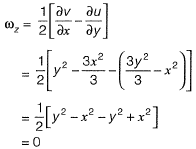
Hence, flow is irrotational.
Q7: A nozzle is so shaped that the average flow velocity changes linearly from 1.5 m/s at the beginning to 15 m/s at its end in a distance of 0.375 m. The magnitude of the convective acceleration (in m/s2) at the end of the nozzle is _______ [2015 : 1 Mark, Set-II]
Ans: Convective acceleration 

Q8: In a two-dimensional steady flow field, in a certain region of the x-y plane, the velocity component in the x-direction is given by vx = x2 and the density varies as Which of the following is a valid expression for the velocity component in the y-direction, vy?
Which of the following is a valid expression for the velocity component in the y-direction, vy?
(a) 
(b) 
(c) vy = - xy
(d) vy = xy
Ans: (c)
Continuity equation in steady flow,
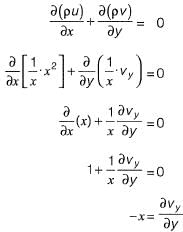
On integrating both sides,
vy=-xy
Q9: A particle moves along a curve whose parametric equations are: x = t3 + 2t, y=-3e-2t and z = 2 sin (5t), where x, y and z show variations of the distance covered by the particle (in cm) with time t(in s). The magnitude of the acceleration of the particle (in cm/s2) at t = 0 is ________. [2014 : 2 Marks, Set-I]
Ans:
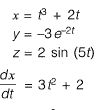
⇒
⇒
⇒
⇒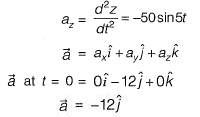
⇒Magnitude of acceleration at t =0

Q10: A plane flow has velocity components 
 and w = 0 along x, y and z directions respectively, where T1 (≠ 0) and T2 (≠ 0) are constants having the dimension of time. The given flow is incompressible if [2014 : 1 Mark, Set-II]
and w = 0 along x, y and z directions respectively, where T1 (≠ 0) and T2 (≠ 0) are constants having the dimension of time. The given flow is incompressible if [2014 : 1 Mark, Set-II]
(a) T1 = - T2
(b) 
(c) 
(d) T1 = T2
Ans: (d)
For a flow to exist, continuity should be satisfied.
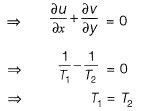
Q11: An incompressible homogeneous fluid is flowing steadily in a variable diameter pipe having the large and small diameters as 15 cm and 5 cm, respectively. If the velocity at a section at the 15 cm diameter portion of the pipe is 2.5 m/s, the velocity of the fluid (in m/s) at a section falling in 5 cm portion of the pipe is _______ . [2014 : 1 Mark, Set-I]
Ans:
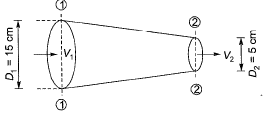
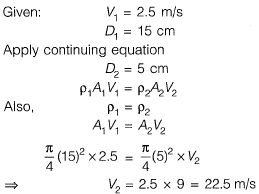
Q12: For a 2-D flow field, the stream function ψ is given as  The magnitude of discharge occurring between the stream line passing through points (0,3) and (3, 4) is [2013 : 1 Mark]
The magnitude of discharge occurring between the stream line passing through points (0,3) and (3, 4) is [2013 : 1 Mark]
(a) 6 units
(b) 3 units
(c) 1.5 units
(d) 2 units
Ans: (b)
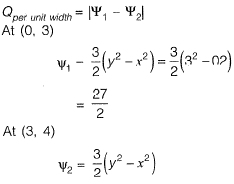

FAQs on Past Year Questions: Fluid Kinematics - Topic wise GATE Past Year Papers for Civil Engineering - Civil Engineering (CE)
| 1. What is fluid kinematics and why is it important in fluid mechanics? |  |
| 2. What are the key parameters used in fluid kinematics? |  |
| 3. How do streamline patterns affect fluid flow? |  |
| 4. What is the difference between laminar and turbulent flow? |  |
| 5. How can the continuity equation be applied in fluid kinematics? |  |
















